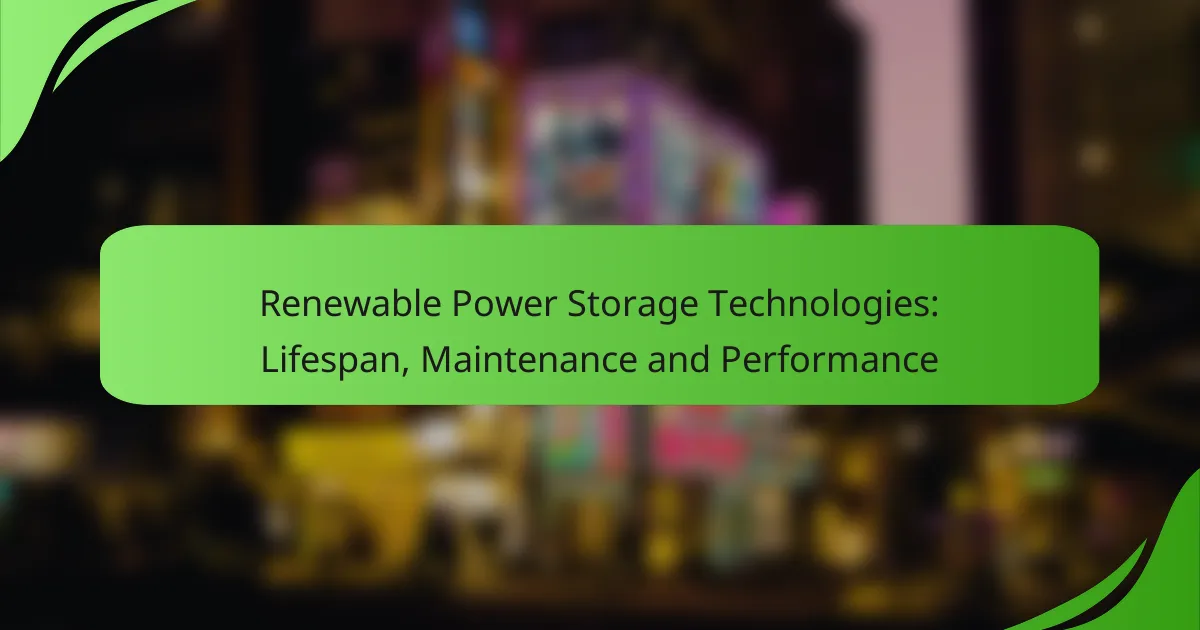Renewable power storage technologies play a crucial role in energy management and grid stability, with options such as lithium-ion batteries, flow batteries, and pumped hydro storage. These systems vary in lifespan and maintenance requirements, typically lasting from a few years to several decades, depending on the technology and usage. Regular maintenance is essential to optimize performance and extend the longevity of these storage solutions.
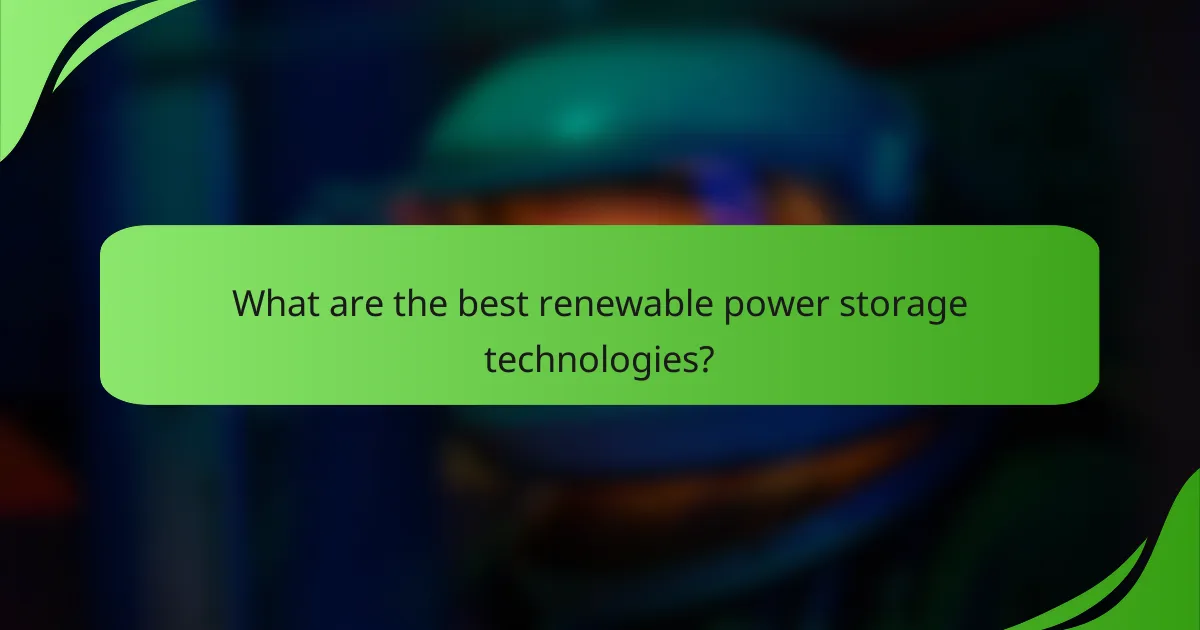
What are the best renewable power storage technologies?
The best renewable power storage technologies include lithium-ion batteries, flow batteries, pumped hydro storage, compressed air energy storage, and thermal energy storage. Each technology has unique characteristics that make it suitable for different applications in energy management and grid stability.
Lithium-ion batteries
Lithium-ion batteries are widely used for energy storage due to their high energy density and efficiency. They typically have a lifespan of 5 to 15 years, depending on usage and environmental conditions.
These batteries are ideal for applications requiring quick response times and frequent cycling, such as residential solar systems. However, they can be costly, and their production raises environmental concerns regarding resource extraction.
Flow batteries
Flow batteries store energy in liquid electrolytes, allowing for scalable energy storage solutions. They have a longer lifespan than lithium-ion batteries, often exceeding 10 years, and can be cycled thousands of times without significant degradation.
These batteries are suitable for large-scale applications, such as renewable energy integration in the grid. However, they typically have lower energy density, making them less ideal for compact installations.
Pumped hydro storage
Pumped hydro storage uses gravitational potential energy by moving water between two reservoirs at different elevations. This technology can provide large-scale energy storage with a lifespan of several decades.
While highly efficient, pumped hydro requires specific geographical conditions and significant initial investment. It is often used for balancing supply and demand in electricity grids, especially in regions with abundant water resources.
Compressed air energy storage
Compressed air energy storage (CAES) involves storing energy by compressing air in underground caverns or tanks. When energy is needed, the compressed air is released to drive turbines and generate electricity.
CAES systems can have long lifespans and are suitable for large-scale applications. However, they require substantial infrastructure and are less efficient than other storage technologies, often losing a significant portion of energy during the compression and expansion processes.
Thermal energy storage
Thermal energy storage systems store excess energy as heat, which can later be converted back into electricity or used for heating. Common methods include molten salt and ice storage, with lifespans that can exceed 20 years.
This technology is particularly useful for concentrating solar power plants and district heating systems. However, it may not be as effective for applications requiring rapid energy release compared to battery systems.
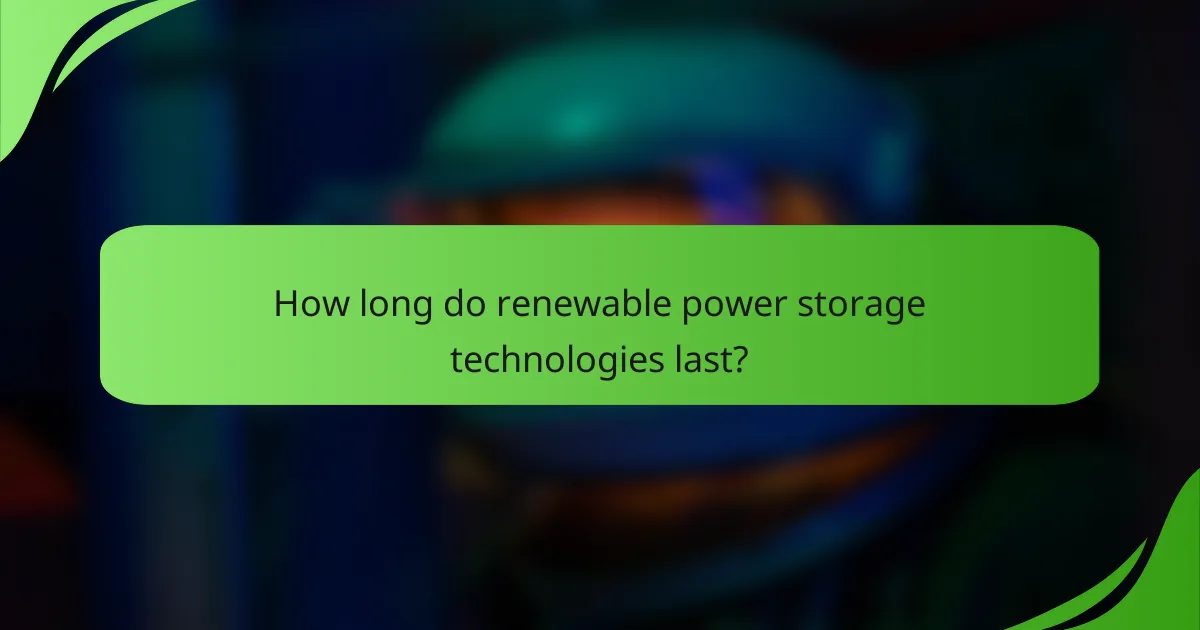
How long do renewable power storage technologies last?
Renewable power storage technologies vary significantly in lifespan, typically ranging from a few years to several decades. The longevity of these systems depends on the type of technology, usage patterns, and maintenance practices.
Lithium-ion battery lifespan
Lithium-ion batteries generally last between 5 to 15 years, depending on factors like charge cycles and temperature conditions. Regular maintenance, such as monitoring charge levels and avoiding extreme temperatures, can help extend their lifespan.
These batteries are widely used in electric vehicles and grid storage due to their high energy density and efficiency. However, they may degrade faster if frequently charged to full capacity or fully discharged.
Flow battery lifespan
Flow batteries can last 10 to 25 years, making them a durable option for large-scale energy storage. Their lifespan is influenced by the quality of the electrolyte and the frequency of maintenance checks.
These systems are particularly suitable for applications requiring long-duration storage, as they can be easily scaled by adding more electrolyte. Regular maintenance of pumps and seals is essential to ensure optimal performance.
Pumped hydro storage lifespan
Pumped hydro storage systems can have a lifespan of 30 to 50 years or more, primarily due to their robust mechanical components. Proper maintenance of the turbines and reservoirs is crucial for maximizing their operational life.
These systems are often used for large-scale energy storage and can provide significant grid stability. Regular inspections and maintenance can prevent costly repairs and extend the system’s lifespan.
Compressed air energy storage lifespan
Compressed air energy storage (CAES) systems typically last around 20 to 40 years, depending on the materials used and the operational conditions. Maintenance of the compression and expansion equipment is vital for ensuring longevity.
CAES is effective for large-scale energy storage and can be integrated into existing natural gas infrastructure. Regular monitoring and maintenance can help identify issues early, preventing major failures and extending system life.
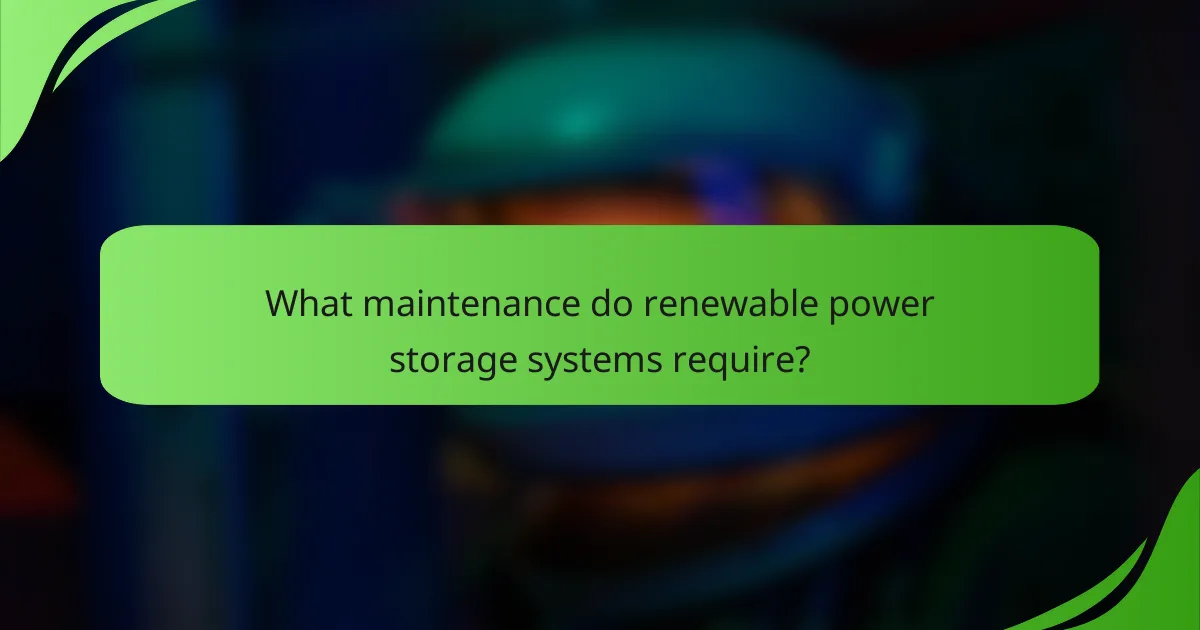
What maintenance do renewable power storage systems require?
Renewable power storage systems require regular maintenance to ensure optimal performance and longevity. The specific maintenance needs vary by technology but generally include monitoring, cleaning, and occasional component replacement.
Maintenance for lithium-ion batteries
Lithium-ion batteries need periodic checks on their state of charge and temperature. Keeping them within recommended temperature ranges (typically 20-25°C) can extend their lifespan and efficiency.
Regularly inspect connections for corrosion and ensure that battery management systems are functioning correctly. Cleaning terminals and ensuring proper ventilation can prevent overheating and enhance performance.
Flow battery maintenance
Flow batteries require maintenance of their electrolyte solutions, which must be monitored for pH and conductivity. Regularly replacing or refreshing the electrolyte can help maintain efficiency and performance.
Inspecting pumps and seals for leaks is crucial, as any loss can affect the system’s operation. Routine cleaning of the system components can also prevent buildup that may hinder performance.
Pumped hydro maintenance
Pumped hydro systems need regular inspections of their mechanical components, including turbines and pumps. Ensuring that these parts are free from debris and functioning smoothly is essential for efficiency.
Water quality should be monitored to prevent corrosion and biological growth in reservoirs. Routine maintenance schedules should be established to check for wear and tear on the infrastructure, especially in regions with varying water levels.
Compressed air energy storage maintenance
Compressed air energy storage systems require checks on compressors and storage vessels for leaks and pressure consistency. Regular maintenance of these components is vital to ensure safety and efficiency.
Monitoring the quality of the air used in the system is important, as contaminants can affect performance. Routine inspections of valves and piping can help prevent failures and maintain optimal operation.
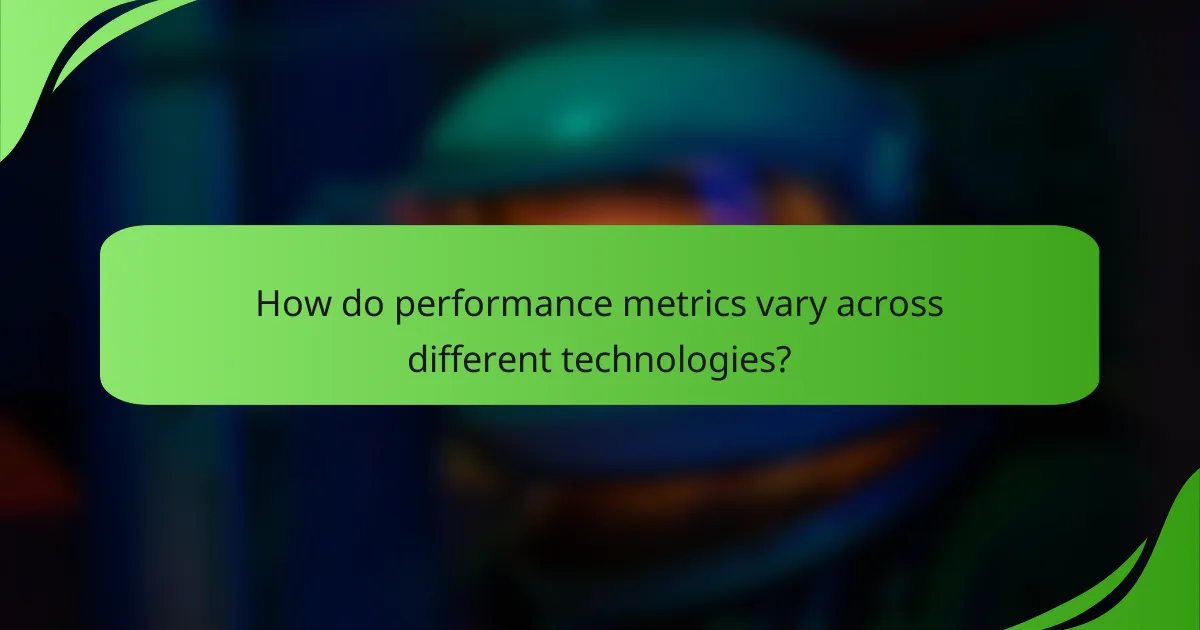
How do performance metrics vary across different technologies?
Performance metrics for renewable power storage technologies differ significantly based on the type of technology used, impacting energy efficiency, cycle life, and response time. Understanding these variations helps in selecting the most suitable storage solution for specific applications.
Energy efficiency comparisons
Energy efficiency refers to the ratio of energy output to energy input in storage systems. Technologies like lithium-ion batteries typically exhibit high energy efficiency, often exceeding 90%, while lead-acid batteries may range from 70% to 85%. When choosing a storage solution, consider the efficiency in relation to the intended use, as higher efficiency can lead to cost savings over time.
For instance, in applications where frequent cycling is required, such as grid stabilization, opting for a more efficient technology can reduce energy losses and operational costs. Always assess the specific energy needs and usage patterns to make an informed decision.
Cycle life analysis
Cycle life indicates how many charge and discharge cycles a storage technology can endure before its capacity significantly degrades. Lithium-ion batteries typically offer a cycle life of 500 to 2,000 cycles, while flow batteries can last even longer, often exceeding 10,000 cycles. This longevity makes flow batteries suitable for applications requiring extensive cycling.
When evaluating cycle life, consider the operational environment and how often the system will be cycled. A longer cycle life can justify a higher initial investment, especially in commercial applications where longevity directly impacts total cost of ownership.
Response time differences
Response time is the duration it takes for a storage system to react to demand changes. Technologies such as ultracapacitors can respond in milliseconds, making them ideal for applications requiring rapid power delivery. In contrast, lithium-ion batteries may take seconds to respond, while lead-acid batteries can take several minutes.
For applications like frequency regulation in power grids, faster response times are crucial. Assess the required response times based on the specific application to ensure the chosen technology meets performance expectations.
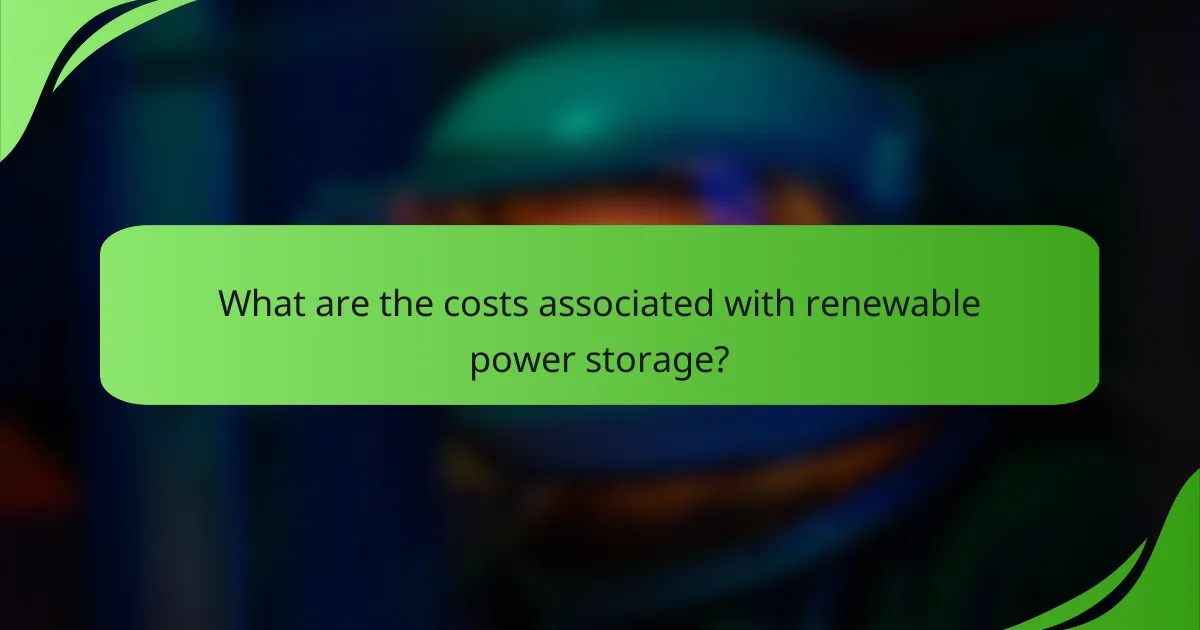
What are the costs associated with renewable power storage?
The costs associated with renewable power storage vary significantly based on the technology used, the scale of the installation, and the specific application. Key factors include initial investment, ongoing operational costs, and overall cost-effectiveness over the system’s lifespan.
Initial investment for lithium-ion systems
Lithium-ion battery systems typically require a substantial initial investment, often ranging from several hundred to a few thousand USD per kilowatt-hour (kWh) of storage capacity. This upfront cost is influenced by factors such as battery chemistry, system design, and installation complexity.
When considering lithium-ion systems, it’s essential to evaluate the total cost of ownership, which includes not only the purchase price but also potential incentives or rebates available in your region. For example, some areas may offer tax credits that can significantly reduce the initial financial burden.
Operational costs for flow batteries
Flow batteries generally have lower operational costs compared to lithium-ion systems, primarily due to their longer lifespan and lower degradation rates. Maintenance costs can be relatively modest, often involving periodic checks and fluid replacements, which can be budgeted at a few percent of the initial investment annually.
However, the initial setup for flow batteries can be higher, so it’s crucial to assess the long-term savings against the upfront costs. In some cases, flow batteries can provide a more economical solution for large-scale energy storage needs, especially in commercial applications.
Cost-effectiveness of pumped hydro
Pumped hydro storage is often regarded as one of the most cost-effective forms of renewable energy storage, particularly for large-scale projects. The initial capital costs can be significant, typically in the range of millions of USD per megawatt (MW), but the operational costs are relatively low due to the efficiency of the system.
Cost-effectiveness can be enhanced by the long lifespan of pumped hydro systems, which can operate for decades with proper maintenance. Additionally, the ability to store large amounts of energy makes it a favorable option for balancing supply and demand in regions with significant renewable energy generation.
